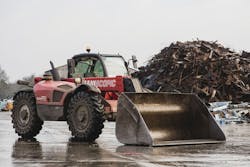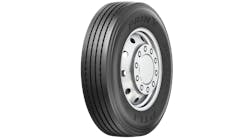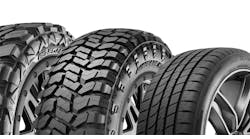In 2010, rental companies began expanding their fleets of telescopic handlers, called telehandlers for short, kicking off a trend that is expected to continue for several years. That’s good news for commercial tire dealers, as the telehandler equipment purchased at the start of the buying spree now needs replacement tires.
More good news is that managing inventory to service telehandlers is relatively easy because just two tire sizes cover most of the telehandler fleet in North America.
Camso Inc. projects the market for telehandler equipment in North America will grow 5% for the next two years. The rental market is growing as well, says Mike Dembe, market development manager at Camso. “Both follow a similar path outpacing the growth we see from the broader economy.”
Although useful in numerous applications, telehandlers are primarily found in the residential and commercial construction industries. In 2015 there was a 10.7% increase in overall construction activity, according to Brad Feeney, director of commercial tire programs for TBC Corp. The greatest amount of growth occurred in the commercial properties sector, with an unusually high spike in manufacturing construction.
“The American Institute of Architects is projecting 2016 to have over an 8% increase over 2015. The telehandler is vital in this multi-story building construction,” says Feeney.
Bruce Besancon, vice president of marketing for Alliance Tire Americas Inc., says construction professionals are realizing the versatility of telehandlers. “In fact, telehandlers are right up there with skid steers as far as versatility and market growth.”
Telehandlers can be used on unimproved surfaces like grass, gravel and construction debris and on pavement. In Europe, telehandlers are used across the board as an all-purpose utility machine at construction sites and on farms, where they can be used to handle hay, forage and supplies on wet, boggy ground as well as on harder surfaces, according to Besancon.
The use of telehandlers tends to be more construction-oriented in the U.S. “You’ll see them delivering pallets of materials up to sites on the second or third story, traveling through mud, debris, hard-packed surfaces and pavement,” Besancon says.
Operators prefer to rent
Dembe says telehandlers usually are rented, not owned, so the bulk of the fleet population exists within rental companies, whose business began to blossom in 2009 as the recession ended.
The rebound of the construction industry combined with construction companies’ newfound preference for renting rather than owning equipment boosted the rental business. “We find that construction companies of all shapes and sizes are a little more risk averse than they were before the recession. They are less apt to own huge fleets of equipment and finance them only to have them sit idle in the case of a downturn. So they find a lot of flexibility and risk reduction in utilizing rental fleets,” says Dembe.
Michelle Lane, director of OTR marketing for Bridgestone Americas Inc., says leading industrial rental companies began to build their telehandler fleets as the construction and oil field-related industries began to recover in the years following the recession.
“The telehandler fleet is relatively young. New telehandler fleets grew between 2010 and 2013 in the industrial rental companies’ inventories,” says Lane. The older equipment in the telehandler fleet now needs new tires. “Depending on a telehandler machine’s application, many are in need of replacement tires. In addition, approximately 20% of telehandler tires are replaced due to operational damage. This is excellent business for those dealers who have invested in mini-boom service vehicles, technicians and foam-fill equipment,” says Lane.
Although expensive, on-site replacement inventory is essential because just-in-time emergency service is critical to the end user, according to Lane. “It is all about uptime for the telehandler’s owner/user. Quality, fast and efficient service is critical. The dealers who can deliver the service can earn a fair and well deserved profit and return on their capital.”
Dembe says there is a trend for large rental companies with multiple outlets to centralize tire purchases at the corporate office. Camso’s aftermarket programs involve a local dealer. “Our programs always include a local partner who we rely on for their expertise, just-in-time service and their inventories of Camso products. They share in the benefits of a national account program we might have.”
Two sizes dominate
The most popular North American machines are fit with two primary tire sizes: 13.00-24 and 14.00-24. “Those two sizes make up at least 80% of the North American telehandler market so it’s easy to manage from an inventory point of view for a commercial tire dealer. It’s not a big stretch to anticipate tire usage and local demand and keep an appropriate amount of these tires in stock,” says Dembe.
There is also a trend toward new low profile bias sizes. The North American market strongly prefers bias ply tires, according to Dembe. Radial is “virtually irrelevant” because it does not provide the stability a telehandler requires when its telescopic boom is extended forward and upward to lift loads. “Bias is preferred, but we see this strong trend for urethane foam-filled and also solid tires. So all three products are popular, and the solid tires have been a growing trend,” says Dembe.
For added durability, some rental companies will spec machines with either foam-filled or solid tires. Others will have them foam-filled after they take delivery, according to Dembe.
All four tires on a telehandler machine are usually replaced at the same time. “Telescopic handlers are classified as a lifting device,” says Dembe. “There can be issues with respect to safety and making sure the tires match up dimensionally so it is advisable to replace in sets of four.”
About 70% of new telehandlers are being purchased by rental companies, according to Besancon. He says telehandlers will definitely be an important force in the replacement tire market. “With a piece of machinery as useful and versatile as a telehandler, owners will be working them hard and operating them in tough environments. Ultimately, they’ll be wearing out tires, and tire dealers will have the opportunity to sell replacements. The Alliance Tire Group is committed to providing a selection of telehandler tires across the most popular sizes — including 13.00-24, 14.00-24, 15.5-25 and 17.5-25 — and a wide range of designs, specs and price points.”
New tires on the way
On April 4, Camso will launch its latest telehandler tires: the TLH 732 for off-road applications and TLH 753 for mixed and hard surface applications. Included in the TLH 753 range are two new low profile sizes: 370/75-28 and 400/75-28. The company is debuting the new tires at the 2016 Rental Show, the American Rental Association’s annual convention and trade show for the equipment rental industry, in Atlanta, Ga., on Feb. 22.
“Both new telehandler tires bring all the benefits of our next generation design and rubber compounding technologies,” says Dembe.
“We packed a whole bunch of performance features into each of these products to make them last longer, perform better and lower users’ overall cost per hour.”
The Alliance Tire Group has several telehandler tires, including the Galaxy Giraffe XLW, the Galaxy MPC (Multi-Purpose Construction) and Primex G3000, to provide price points and design options for telehandler owners. “We are also developing a solid tire for telehandlers, which will be the ultimate option for units operating in harsh environments and where downtime is just never an option,” says Besancon.
TBC offers a wide range of products in all of the popular sizes for the telehandler business with its core brands, Power King and Akuret. In the Power King line, TBC carries the Rim Guard HD, Road Grader, Industrial Loader and xERT-3. The Power King xERT-3 is a radial E-3/L-3 tire designed for superior traction, longer wear and a smooth ride. In the Akuret line, TBC carries the Sidewinder Mudder XHD, Road Grader+ HD, Road Grader Ultra HD and Radial G-2 GLR82.
“TBC has a strong development plan to continue growth in the OTR market for our customers, including the low profile sizes for telehandlers,” says Feeney.
Dealers will have yet another product to choose from later this year and into 2017 when Continental Tire the Americas LLC introduces a replacement solid tire for telehandlers. Continental will only say that its current offering of solid tires for telehandlers “doesn’t fit the overall need of this segment.”
According to Gary Sass, U.S. market manager for Continental’s commercial specialty tires business unit, the company is “definitely interested” in the telehandler market. “We do see it growing in the U.S with commercial and residential construction starting to rebound.” Sass says solid tires could represent up to 40% of the telehandler market.
The replacement market for telehandler tires is a real showcase for the importance of a knowledgeable tire dealer, according to Besancon. “The growth in telehandlers is a great opportunity for tire dealers, and it also requires them to recognize the special demands that telehandler tires have to meet,” he says.
Above all, the tires must be stable for the telehandler to safely lift loads. “As the boom extends, load shifts among the wheel positions, so the tires have to be engineered to perform under extreme variances of load weights and vectors. The tread needs to be tractive in a wide range of conditions, so lug design and compound have to be engineered with versatility in mind. When it comes to specialized equipment like telehandlers and the specialized tires they require, the expertise of a tire dealer is extremely valuable to the customer.” ?




